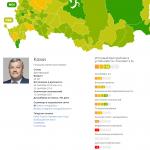In order for a child to form higher feelings (moral, aesthetic, cognitive), he must have a concept of good and bad, beautiful and ugly, as well as a cognitive need. Feelings develop gradually. Initially, children capture only the direct meaning of events, later - their generalized meaning. In the experiment of K. N. Kornilov, children answered the question why it was impossible to fight with a friend. Younger preschoolers answered: “You can’t fight, otherwise you will get right in the eye”, “They can take you to the police.” Older preschoolers said: “You can’t fight with your comrades, because it’s a shame to offend them.”
Preschoolers are characterized by the fusion of higher feelings. The child evaluates as “good” objects and phenomena that cause him both aesthetic experiences (good means beautiful), and ethical (good means kind), and intellectual (good means interesting). One and the same object causes an experience in which aesthetic, ethical, cognitive feelings are merged. When perceiving The Tale of Tsar Saltan, a preschooler (according to N.A. Menchinskaya) shows not only curiosity, but also a moral sense. "Is he ours or not ours, good or bad?" - the child asks about the heroes of the fairy tale.
In the future, with the formation of the ability to analyze and evaluate in accordance with specific moral or aesthetic criteria, the syncretic (fused) feeling is differentiated into aesthetic, ethical, intellectual.
Higher feelings begin to form from the age of two or three. The highest feelings include intellectual, aesthetic and moral.
Feelings that arise in the process of cognitive activity are called intellectual. These include curiosity, curiosity, surprise, a sense of the new, a sense of humor. A sense of humor is manifested in preschoolers in the process of learning about reality. Children who have a certain correct idea of \u200b\u200bthe environment love inconsistencies (assigning objects of unusual qualities).
“3, 7, 4. The other day, Gena played such a game, laughing loudly at the same time. Gena: “You are a gun”, Sasha: “You are a book”, Gena: “You are a sled”, Sasha: “You are skis” (from the diary of N. A. Menchinskaya).
Aesthetic feelings are manifested in an emotional attitude to the heroic, comic, ugly, beautiful - in nature, in life, in art, in the process of perception and creativity. M. Yu. Lermontov wrote: “When I was three years old, there was a song that made me cry: I can’t remember it now, but I’m sure that if I had heard it, it would have produced the same effect. It was sung to me by my dead mother.
The aesthetic attitude of children to reality is reflected in their drawings and poems. A 6-year-old boy wrote a poem: “O wind, wind, why are you blowing like that? You sway in the ravine and you interfere with thinking. Preschoolers have experiences associated with the satisfaction or dissatisfaction of their aspirations to comply with the requirements of social life, that is, moral feelings. The first manifestations of a sense of duty are observed at the age of 4-5, when, on the basis of existing knowledge, skills, moral consciousness begins to emerge, when the child begins to understand the requirements placed on him, relate them to his actions and actions, to the behavior of other people (adults and peers ).
Preschoolers also have such ethical experiences as a sense of pride and shame. “The internal condition for the emergence of a sense of pride aimed at specific virtues is the formation in the child’s mind of a connection between the idea of these virtues and a positive assessment from others.” So, children of 4-5 years old are proud of their quality indicators in many types of activities: the ability to dance well, run fast, count; manifestation of moral qualities (restraint, obedience), are proud of their parents. As shown in the study by R. Kh. Shakurov, the development of pride occurs not only under the influence of a positive, but also a negative assessment, which causes a feeling of shame. Shame arises in such psychological situations when a child wants to act in accordance with positively evaluated patterns of behavior, but actually performs actions and deeds that are negatively evaluated by adults; he wants to perform an action that he could be proud of in front of those present, but he does it “not like that”; he feels that others expect him to succeed, but he fails and does not live up to their expectations. The emergence of shame is dependent on the development of pride. If a child is proud of his ability to speak correctly, recite poems, and be accurate, then he is ashamed of mistakes in speech, failures in reproducing poems, ashamed to show himself as a "dirty one".
At preschool age, a feeling of friendship develops. The following criteria for friendly relations are distinguished: preference, sympathy, sympathy, responsiveness, manifested between individual children, but not to the detriment of others; interest in the activities of peers, the desire and ability to agree on a joint game and the role played in it; manifestation of care, assistance; the ability to give up personal desires (to act fairly, while receiving satisfaction). In the experiments of T. A. Markova, preschoolers had to talk about their actions in the proposed situation: “If you were walking in the kindergarten area with other children and suddenly one of the children fell near you and hurt your leg. What would you do?" 63 % children replied that they would report this incident to the teacher; 29% would raise, seat the child and call the teacher; 8% would ask if it hurts a lot, would carefully seat the child, and then they would call the teacher. Such responses indicate that friendly feelings do not always find their adequate expression in the actions of older preschoolers. For younger preschoolers, friendship is characteristic in turn with many children. The motive of friendship is to play together. In older preschoolers, friendship acquires a more intimate character; its motive may be mutual inclinations, sympathies, and interests.
By the end of preschool childhood, higher feelings are increasingly becoming the motives for the child's behavior. Through feelings, the actions, actions, desires of the child are regulated in accordance with the established ethical, aesthetic requirements of society.
Ekaterina Mikhailovna Pashkina
Chief Physician of the Central Clinical Hospital of Omsk
Reading time: 11 minutes
A A
Article last updated: 04/03/2019
In the preschool period, there is an intensive development of the personality, its physiological and psychological characteristics. A preschool child is completely open to the perception of fresh knowledge. He seeks to know the surrounding reality and determine his place among other people. All thought processes are inseparable from emotions, which the baby cannot develop on his own, adults help him in this. Find out the features of the emotional development of a preschooler in this article.
Features of the development of the emotional sphere in preschoolers
To adapt in any social environment, it is necessary to engage in emotional development. The favorable conditions created by the baby’s relatives will allow him to learn how to manage his emotions, direct them in the right direction. If parents do not focus on the development of emotions, their child will have problems communicating with peers, adapting to a team, and symptoms of psycho-emotional development will appear:
- anxiety,
- aggressiveness,
- hostile attitude.
In kindergartens, conflict situations often arise between children associated with the manifestation of aggression, self-affirmation at the expense of others. Conflicts give rise to difficult and acute experiences:
- fear,
- resentment
- anger,
- hatred,
- impotence.
This can leave a psychological trauma for life, the child can withdraw into himself, lose confidence in his abilities, or, conversely, stop obeying the demands of adults, begin to question their authority, rebel, show obstinacy, stubbornness and self-will.
The joint efforts of parents and educator in a preschool institution are aimed at teaching the child to be aware of his emotions, recognize and manage them.


To talk about what the child feels and experiences, it is necessary to own emotional vocabulary. A properly developed technique will allow you to form moral behavior, teach a child to get rid of the feeling of fear, anger, without splashing it out on others.
The child must not only take control of their own emotions, but also learn to recognize others through:It is necessary to teach the child to express their negative emotions in a socially safe way.
- facial expressions
- gestures,
- pose,
- the words,
- voice intonation.
For full emotional development, the baby must learn:
- empathize, i.e. share and reproduce the experiences of other people;
- sympathize - to experience the emotional state of another person yourself;
- promote.
Conditions for full emotional development
In preschool children, the emotional world is rich and diverse. Emotions allow you to be more aware of what is happening. Through them there is an expression of attitude to the world around, regardless of whether they are positive or negative. In turn, positive experiences inspire creative success.
From the age of 4, children develop the ability to empathize with fictional characters in books, films, and cartoons. They learn to imagine the state of mind of the characters who find themselves in a particular situation.
Circle of friends
In order for the baby to develop himself as a person, he needs to be in constant interaction with peers and adults.

Older preschoolers attach great importance to friendship and mutual assistance. They support and protect their friends, believing their actions are right, even if they are not.
Cultural events and creativity
Important for the emotional development of preschool children are joint cultural events with their parents: visiting various exhibitions, museums, concerts, theaters (opera, ballet, drama and puppet). The aesthetic sense of beauty is formed from an early age.
For emotional development, the following methods and means of aesthetic education are used:
- listening to music,
- singing,
- learning to play musical instruments,
- artistic creation,
- staging theatrical performances,
- reading fiction with the obligatory analysis of the material read,
- drawing illustrations for the read works.
When creating conditions for emotional development, it is necessary to take into account the age of the child, his individual characteristics, interests, aspirations. Parents should identify what can interest the baby, give him the opportunity to express his opinion or decide on his own which circle he would like to get into.
Praise
The importance of praise cannot be underestimated. It affects the formation of adequate self-esteem of a small person. Even if something does not work out for him or he is mistaken in something, it is important to tell him “you can”, “you can”, “it will work out”.
Support your baby, encourage initiative and praise even the smallest victories - this is how you raise a confident person who is not afraid to try something new.
Relationships in the family: how to identify the problem
Especially important in the emotional development of the baby is the psychological climate in the family. Some children develop emotional disturbances due to situations occurring at home. Parents may not even know about it.
The “Family Drawing” technique will help to diagnose a hidden problem. The kid is invited to draw his family on a white sheet of paper, without specifying what exactly is invested in the concept of "family". Sometimes you can see a lot more in a picture than a child can tell in words.
Means of emotional development
Means of emotional development include a whole range of activities in which creative abilities are manifested:
- Painting,
- plasticine molding,
- cutting out of cardboard or paper,
- creation of various crafts.
So the child develops independence, fantasy, imagination, acquires new skills.
Drawing and modeling
Through drawings, preschoolers express their emotions. Usually children draw what pleases them and what upsets them, causes fear or anxiety. Often the projection of objects of fear in the picture, even if they are non-existent, imaginary, allows you to deal with them. You can draw with pencils, brushes, fingers.
By the brightness and severity of the lines of the picture, you can see the relationship of the baby to any event taking place in his life.
It develops the imagination well and evokes a whole range of emotions modeling from plasticine or dough.
Reading and discussion
Reading books contributes to emotional, moral and spiritual enrichment. Children plunge into the book world, begin to empathize with the main characters, learn a lot about life's problems and how to solve them. After reading the work with children, they analyze each problem and each character, the features of his character, reveal which actions he committed were right, moral, and which were wrong.
With the help of books and discussion of the situations read, you can teach to be honest, kind, confident and courageous.
Music lessons
A good option for the development of the emotional sphere, including the aesthetic sense, is a musical technique. Music is used both for dancing and as a background during other creative activities.
In the rhythms of dance movements, the character of children is manifested, their thoughts, feelings, mood are revealed. Properly selected pieces of music are a means of calming, relaxing and relieving psychological stress, they form the basis of the aesthetic taste of the baby.

Exercises for developing and understanding emotions
Means of training the emotional sphere include various exercises. One of them is performed using cards with photographs of people or drawings of animals, on the faces of which various emotions are depicted (sadness, joy, anger, anger, etc.). The kid must determine what these emotions are and demonstrate them on his face.
Psycho-gymnastics- an effective technique that develops the mental, physical and emotional spheres as a whole. For example, a baby can embody the image of a cheerful bunny galloping across a clearing. He will smile, jump and wave his arms.
The features of these exercises are the alternation of smooth and sharp movements, slow and fast. The muscles will tense up and then relax.
Caring for animals and plants
To teach a child to take care of nature, you need to give him the opportunity to take care of plants and animals. It is necessary to show him how beautiful and, at the same time, fragile our nature is on the example of beautiful fragrant flowers. It is necessary to explain how long it takes to take care of a plant so that it blooms and bears fruit - and all labor can be destroyed in an instant.
The child must learn to take care of our smaller brothers. He needs to realize how the life of animals depends on a person, to understand that we are responsible for those whom we have taught.

You don't have to have pets to do this. You can feed ducks in the pond, pigeons in the yard, feed homeless dogs and cats. You can get a hamster, parrot, cat or dog at home and give the baby the opportunity not only to feed and stroke the animal, but also to clean up after him, bathe him, walk him. All these procedures develop independence and discipline.
Caring for plants and animals, the baby must be aware of the importance of this matter, develop an aesthetic attitude towards nature, learn to love it, and receive a charge of positive emotions.
Game as a way of learning
Play is the main activity of every child. It is full of emotions, actions and improvisation. It is a means of developing the physical, cognitive and social condition. The method of learning with the help of games is the most correct and intelligible.
For a good teacher, the main thing is not to achieve the final result with the entire group of children, but to conduct all classes in such a way that they are interested. Preschoolers should be comfortable and interested in learning new things..
In order for the studied material to be firmly assimilated, it must be presented and presented consistently, and not chaotically.
A well-designed teaching methodology does not include universal classes designed for the average child, but individual ones, taking into account personal characteristics, so that each child can feel their uniqueness and develop their abilities.

The child must actively participate in his upbringing. He must be treated with respect so that he does not lose his self-esteem.
Consultation for educators
Prepared by: educator GDOU CRR - d / s No. 45 Ivanova K.V.
The value of emotions and feelings in the life of a preschooler.
Modern society pays more and more attention to the personality of a person, his individuality, emotional well-being and the factors on which it depends. Especially important from this point of view is the preschool age, in which the foundations of the personality are formed, stable mechanisms of response to various environmental influences are formed.
The emotional sphere is one of the main regulatory systems that provide active forms of life of the organism (PK. Anokhin, V.K. Vilyunas, K.E. Izard, S.L. Rubinshtein). In humans, the main function of emotions is that thanks to them we better understand each other, we can, without using speech, judge each other's state and better tune in to joint activities and communication. People belonging to different cultures are able to accurately perceive and evaluate the expressions of a human face, determining the basic emotions. states. This also applies to those peoples who have never been in contact with each other. This fact proves the innate function of emotions, but not all of them, some of them are acquired in the process of life through training and education.
It is important to note the certain influence of emotions on mental processes.
For example, a good mood improves memory. A person quickly forgets what is emotionally neutral for him and does not matter much, and what is unbearably hard for him to remember. Happiness tends to contribute to the completion of the cognitive task, while unhappiness tends to inhibit its completion. Volitional processes are closely related to emotions. The mood is reflected at all stages of the act of will: on the awareness of the motive, decision-making and deployment of the process of achieving the goal, culminating in the decision. But not only emotions affect volitional processes, but the very process of achieving a goal can cause a whole range of feelings, including negative ones (annoyance, resentment).
The emotional sphere of a person has a complex multi-level structure and includes an emotional tone, emotions proper, emotional properties of a person and feelings.
Feelings or emotions are called a person's experiences of his attitude to what he knows or does, to other people and to himself. Emotions are a simpler, direct experience in the moment. Feelings are the highest form of emotional states, reflecting the attitude of a person to the object of his stable needs, fixed in the direction of the personality. They are characterized by durability and stability; have an objective character: they are caused by facts, events, people and circumstances in relation to which a person has formed stable motives.
Emotions cannot arise by themselves without a reason. The source of emotions is objective reality, they are social in nature. Feelings are based, first of all, on the needs that arose in the process of human social development and are related to the relationship between people: the need for mutual communication, the need for work, the need to act in accordance with the moral standards accepted in society, etc.
The feelings of a preschooler are involuntary. They flash quickly and go out quickly. Rough fun is replaced by tears. The whole life of a child of early and preschool age is subject to his feelings. He still cannot control his feelings.
The mood of the child largely depends on relationships with adults and peers. If adults are attentive to the child, respect him as a person, then he experiences emotional well-being. The positive qualities of the child, a benevolent attitude towards other people, are manifested and consolidated.
If adults bring grief to a child, then he acutely experiences a feeling of dissatisfaction, transferring, in turn, to the people around him, his toys a negative attitude.
By observing certain game situations, the educator can understand what emotions the child is experiencing, and what impact the detected emotional states can have on personality development. In the process of observing children's play, you need to pay attention to the following. Do the children want to play together or try to avoid each other? How do you get involved in game learning? Do they understand someone else's initiative or resist it? Who is always in the center of the game, and who silently watched from afar? What kind of relationships prevail in the game - benevolent or conflicting? What emotions prevail - positive or negative?
Emotional distress associated with communication difficulties can lead to a variety of behaviors in children.
The first is unbalanced children, impulsive behavior characteristic of quickly excitable children. In the event of conflicts with peers, the emotions of these children are manifested in outbursts of anger, loud crying, and desperate resentment. Negative emotions in this case can be associated with both serious reasons and the most insignificant ones. Quickly flashing, they just as quickly fade away. Their emotional incontinence and impulsiveness lead to the destruction of the game, to conflicts and fights. However, these manifestations are situational, ideas about other children remain positive and do not interfere with communication.
The second type of behavior is characterized by a persistent negative attitude towards communication. Resentment, discontent, hostility linger in memory for a long time, but they are more restrained than children of the first type. They avoid communication and seem to be indifferent to others. However, they closely, but imperceptibly, follow the events in the group and the relationship between teachers and children. The emotional distress of these children is associated with dissatisfaction with the attitude of the educator towards them, dissatisfaction with the children, and no desire to go to the garden.
The main feature of the behavior of children of the third type is the presence of numerous fears in them. Normal behavior of fear should be distinguished from fear as evidence of emotional distress. The fear of children with emotional distress, as a rule, is not associated with any objects or situations and manifests itself in the form of anxiety, unreasonable, pointless fear.
The stronger the emotional distress of the child, the greater the possibility of situations that cause difficulties in the interaction of the child with the outside world. The child becomes less contact, anxious, experiences a variety of persistent fears, self-esteem decreases. Other children, on the contrary, begin to show aggressive behavior, which manifests itself in a physical form (fighting, destruction, injuring themselves or others) or verbally.
An important point in the education of emotions and feelings in preschoolers is to give an idea of emotions and feelings, why people need them. It is necessary to teach children to recognize basic emotions in pictures by the end of preschool childhood. (fear, anger, joy, sadness, surprise, calm). Teach children to identify both their own and other people's emotions and feelings. Be considerate of yourself and those around you. Help the child learn to manage their emotions, restrain anger, violent discontent and sometimes violent fun.
The teacher should strive to ensure that children are enriched with emotional experiences that have a positive meaning. This is possible with the help of special exercises, games, tasks and more. Experts have long confirmed that the development of emotions and feelings in preschoolers depends on a number of conditions.
- Emotions and feelings are formed in the process of communication of the child with peers.
(With a lack of emotional contacts, a delay in emotional development may occur, which persists for life. The teacher should strive to establish bodily emotional contacts with each child.
- With specially organized activities (music classes, reading books, fine arts - creativity)
- In an age-appropriate activity (in preschool age - a game)
- In the process of performing joint labor activities (cleaning the group).
The relationship of a person to the world around him is not only understood by him and manifested in actions, but also experienced in the form of emotions. Emotions are one of the forms of reflection by consciousness of the real world.
Accompanying almost any manifestation of the subject's activity, emotions serve as one of the main mechanisms of internal regulation of mental activity and behavior aimed at meeting actual needs. Emotion development personality child
The emotional sphere is an important component in the development of preschoolers, since no communication, interaction will be effective if its participants are not able, firstly, to "read" the emotional state of another, and secondly, to control their emotions. Understanding your emotions and feelings is also an important point in the formation of the personality of a growing person.
The formation of a person's emotions is the most important condition for the development of him as a person. The extraordinary diversity of human emotions is explained by the complexity of the relationship between the objects of his needs, the specific conditions of occurrence and the activities aimed at achieving them. The class of emotions includes: moods, feelings, affects, passions, stresses. These are the so-called "pure" emotions. They are included in all mental processes and human states.
Preschool childhood is a very short period in a person's life, only the first seven years. One of the main directions of mental development in preschool age is the formation of the foundations of personality. The child begins to realize his "I", his activity, activity, begins to objectively evaluate himself. The emotional life of a preschooler becomes more complicated: the content of emotions is enriched, higher feelings are formed.
A preschooler at 4-5 years old is a person with a rich and diverse emotional world, he deeply feels, his experiences, first of all, are closely connected with relationships in the circle of loved ones.
The emotional development of a preschooler is associated, first of all, with the emergence of new interests, motives and needs. The most important change in the motivational sphere is the emergence of social motives that are no longer determined by the achievement of narrowly personal utilitarian goals. Therefore, social emotions and moral feelings begin to develop intensively.
Emotions play an important role in a child's life. They help to perceive reality and respond to it. An emotional anticipation is formed in a preschooler, which makes him worry about the possible results of his activity, to anticipate the reaction of other people to his actions. Therefore, the role of emotions in the activity of the child changes significantly. If earlier the child felt joy because he got the desired result, now he is happy because he can get this result. If earlier he fulfilled a moral standard in order to deserve a positive assessment, now he fulfills it, foreseeing how those around him will be delighted with his act.
At preschool age, the emotional world of the child is richer and more diverse. From basic emotions (joy, fear) he moves to a more complex range of feelings: happy and angry, jealous and sad. The language of such feelings as the expression of shades of experiences with the help of glances, gestures, smiles, movements, voice intonations is also assimilated.
It is at preschool age that a child masters the highest forms of expression - the expression of feelings through intonation, facial expressions, pantomime, which helps him understand the experiences of another person, "discover" them for himself.
The whole life of a child of early and preschool age is subject to his feelings. He still cannot control his feelings. Therefore, children are much more prone to mood swings than adults. It is easy to amuse them, but it is even easier to upset or offend, since they almost do not know themselves at all and do not know how to control themselves. That is why they are able to experience a whole gamut of feelings and excitement in an unusually short period of time. The mood of the child largely depends on relationships with adults and peers.
The development of emotions and feelings in preschoolers depends on a number of conditions:
1. Emotions and feelings are formed in the process of communication of the child with peers.
Empathy with peers largely depends on the situation and position of the child. In conditions of acute personal rivalry, emotions overwhelm the preschooler, and the number of negative expressions addressed to a peer increases sharply. In group competitions, the interests of the group serve as the main core, and success or failure is shared by everyone together, the strength and amount of negative expression decreases, because against the general background of the group, personal successes and failures are less noticeable.
- 2. With specially organized activities (for example, music lessons, reading fairy tales), children learn to experience certain feelings associated with perception (for example, music). The child experiences the brightest positive emotions in a situation of comparing himself with a positive literary hero, actively empathizing with him. The preschooler makes such a comparison only mentally and with confidence that in a similar situation he would have acted the same way. Therefore, there are no negative emotions towards the character.
- 3. Emotions and feelings develop very intensively in the type of activity appropriate for the age of preschoolers - in a game saturated with experiences.
A powerful factor in the development of humane feelings is a role-playing game. Role-playing actions and relationships help the preschooler to understand the other, take into account his position, mood, desire.
4. In the process of labor activity aimed at achieving a result useful to others, new emotional experiences arise: joy from common success, sympathy for the efforts of comrades, satisfaction from the good performance of one's duties, dissatisfaction with one's poor work.
An important feature of emotional development is the close connection with the situation of direct communication of experiences through the prism of direct communicative relations.
In general, children are optimistic about life situations. They have a cheerful, cheerful mood. Usually, the emotions and feelings of preschoolers are accompanied by expressive movements: facial expressions, pantomime, voice reactions. Expressive movements are one of the means of communication. The development of emotions and feelings is associated with the development of other mental processes and, to the greatest extent, with speech.
One of the most important components of the moral development of children is the development of empathy as a person's ability to sympathize with other people and empathize with them, to understand their conditions. The study of the child's emotions plays an important role in identifying the causes of the child's behavior, allows you to determine his attitude to the world.





